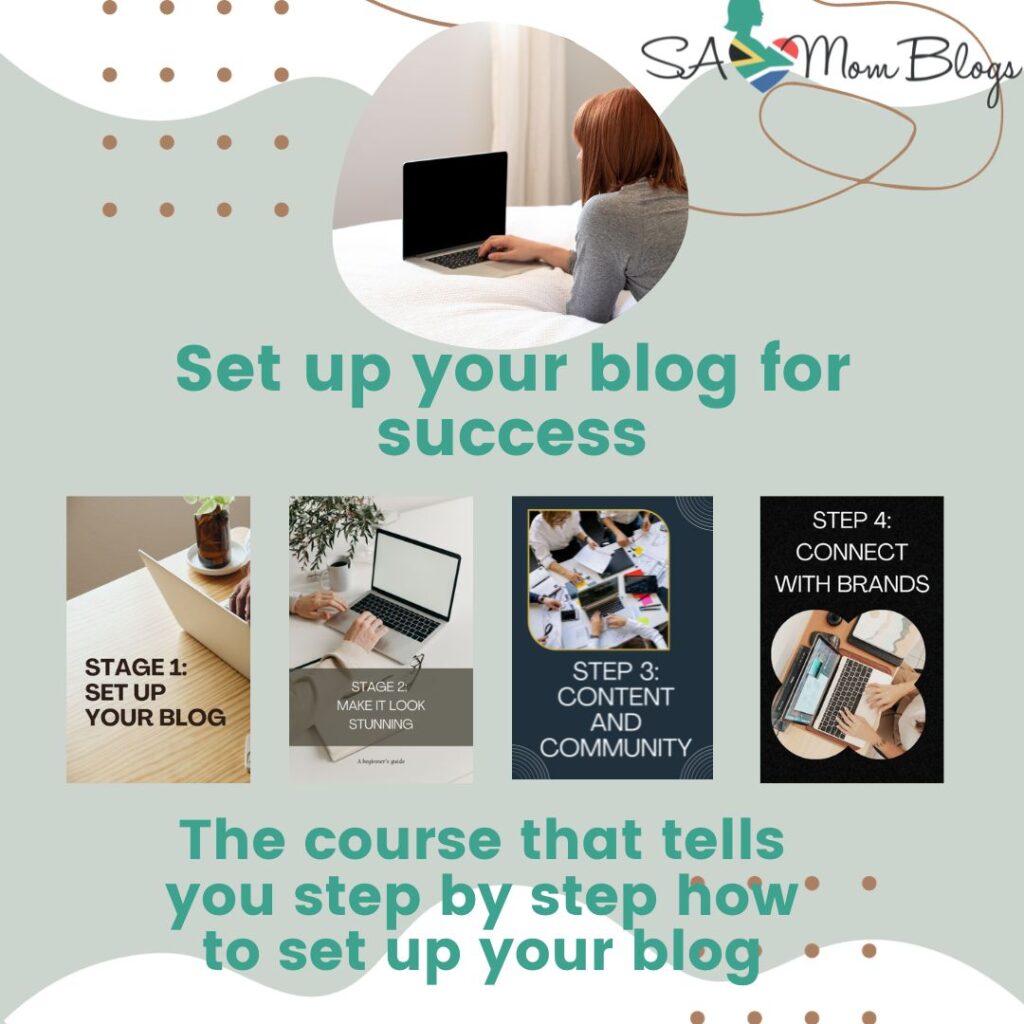So.. you’d like to share your story, your passion and your words with everyone? Welcome to the wonderful world of blogging! It may seem overwhelming, but it can be done, with perseverance, consistency, and a lot of learning. I’ve been blogging for more than ten years and I still take the opportunity to learn new things. But, if you’re starting from scratch, you’ve come to the right place to get an outline of how to start a blog in South Africa and make money blogging.

The steps for setting up a blog in SA are similar to the rest of the world, but I’ve included a few local service providers where possible and local links for where you can sign up for support and opportunities.
STEP ONE: Set up a blog in South Africa
1- Choose Your Blog Niche: Your What and Why
What would you like to write about? It has to be something that you’re interested in, otherwise you won’t have the passion to keep going. It could be an online journal about your family. It could be a record of your child. It could be all about food. Maybe you love fashion or beauty? Perhaps you know everything about finance? What is your skill? Think about that and think about a name for your blog. The more specific and unique, the better.
Identifying Profitable Niches
Our rainbow nation’s rich diversity gives bloggers many options when it comes to topics. You want a subject that sparks your interest and is also likely to attract readers. When thinking about your field, look for a sweet spot between your passions and what people want to read.
Some blogging niches that work well here include:
- Personal finance and budgeting such as tips on saving money, investing, and managing debt
- Food and recipes with easy home-cooking ideas or traditional dishes
- Local travel and tourism, from city escapes to hidden gems and nature trails
- Fashion and beauty focused on local brands, trends, and natural hair care
- Parenting and family life for families with everyday tips
- Small business, side hustles, and entrepreneurship for those starting out
- Education and study tips for learners and students
Before you choose, run a quick Google search or check the trends on platforms like Google Trends or X (Twitter). See what people are posting and sharing about your topic. Also, visit well-known local blogs to get an idea of what’s already out there and where you can offer something fresh.
Understanding Your Audience’s Needs and Interests
Your target demographic guides every decision you make on your blog, from topics to tone to timing. Start by defining who your ideal reader is:
- Age group: Are you writing for teens, parents, or retirees?
- Location: Do you want to reach nationwide or focus on a specific city or province?
- Common challenges: What problems do they face that your blog could help with?
- What they already read: Which local blogs, magazines, or social channels do they follow?
To get to know your audience better, try these quick steps:
- Join local groups on Facebook, WhatsApp, or Reddit to see what people are keen on discussing.
- Use polls or questions on Instagram Stories, X, or Facebook to get feedback directly.
- Look at popular content on YouTube and TikTok in your niche.
A clear picture of your audience helps you write posts that feel like they’re speaking to each reader. When your blog solves their real-life problems or taps into their interests, you’ll build trust and keep readers coming back.
Keep your niche and your audience at the center as you move forward. This focus will shape everything you create next, bringing your blog to life for the people who need it most.
2- Your home and street address on the net: Hosting and domain
Think of your blog or website as needing a place to stay. You could use someone else’s spot for free (e.g. wordpress.com or blogspot.com) but it won’t really be your place which you can do your own thing and advertise and monetise and have your own place. I’ve also written this post about my bad experiences with a free host. You need a host (place) and you need to register a domain (street address e.g. www.yoursite.co.za) for your blog.

Two places I recommend and use are: Hostgator and Domains.co.za. Do your research and make sure that “https” is included (SSL). (Update: I’m currently only using Domains.co.za.)
3- Choose a blogging platform: I suggest: Add WordPress
There are a lot of platforms you can choose to blog on. In my opinion there is a lot more you can do with WordPress. Normally you can get your host to add WordPress for you (Domains.co.za did it for me) and for Hostgator it’s just a few clicks. It’s pretty simple and they will help you.
- WordPress
- Tons of free and paid themes to make your blog look professional
- Built-in tools for SEO, stats, and sharing posts
- Great for everyone, from total beginners to more advanced users
- Huge library of plugins
- I don’t recommend WordPress.com (free version) as you will not be able to monetise it or have full control.
- Wix
- Drag-and-drop design, no coding needed
- Plenty of templates that you can tweak for your brand
- App Market for adding extra features like newsletters and photo galleries
- Free plan with Wix branding or affordable paid plans to use your own domain
- Blogger
- 100% free, owned by Google
- Simple setup and maintenance
- Connects easily to your Google account
- Fewer custom design options but gets you blogging quickly
- Reliable for basic blogging with no costs
It’s important to have a platform strategy. You might enjoy blogging for free at blogger or WordPress.com, but if you are in this for the long haul, and want to think about making money in the future, you’ll go the self-hosted platform route.
STEP TWO: Appearance
1-Set up a theme
There are loads of themes out there for you to choose from. Choose something that will fit your topic. Choose a theme that is reliable and is from a reputable place. I’ve made all the mistakes here in the past just Googling things and landing up with problems.
I recommend Kadence as your base theme from which you can build onto using one of their starter templates. Under Appearance => Themes in your dashboard you can upload Kadence and select starter themes from there. There are loads to choose from in a whole lot of different niches.
Another good one, which I use for my blogs, is Restored316 (which also uses Kadence as a base).
2-Make your logo and flavicon
You can get a graphic designer to help you, or you can go into Canva and make something for yourself. This will be your brand of your blog and be part of your unique flavour. You’ll also need a tiny logo to put in the address bar of a browser – an icon that shows your mark, too.
3-Create Four Essential Pages
You need at least these four basic pages:
- Home page
- About page (tell everyone about yourself and your background)
- Contact page (so people can get hold of you – do a form, not an email, as the spam bots will create problems for you.)
- Privacy Policy
4- Permalink
Under Settings => Permalink, make sure that you do a custom structure of category and post name. This is to help you with SEO, it’s better than just having the date of your post on your URL.
STEP THREE: Captivating Content and an Engaged Community
1- Start blogging
Begin with creating excellent blog posts. Pour out your heart about your life, or create posts about things that people are searching for in your niche. This is actually the most important thing. Good, useful writing will be things that people will enjoy and share. And if it’s your cheap version of therapy to write about your life – that’s fantastic too.
To take that first step to write your first blog post is a huge achievement you should be proud of.

2-Set up an opt in form for subscribers and create a professional email
Do not rely only on social media. You can have all the followers in the world and they can kick you off when they feel like it. Anyone who has been in this game long enough has experienced it, or at least knows someone who has.
If you have your own email list of subscribers, that is incredibly valuable. You can provide a newsletter to your email list with your latest blog posts and other news.
I currently use MailerLite which has a lot of things you can do in terms of graphics and integrations. I’ve also used MailPoet in the past which integrates into WordPress. There’s a load of other options: do your research.
You also need to create a professional email which is part of your branding. You can do this with your host.
3- Promote Your Blog: Share your posts on social media
Find out where your audience hangs out and use that social media to promote your posts. If you do a lot of cooking and arts and crafts, Pinterest is definitely going to help you. Facebook and Instagram are good for moms as well. With Instagram you have to use the link in your bio to promote your blog. With Facebook, use a Facebook page and use that to post into relevant groups (after checking on the rules of the groups. Some of them you may have to pay, or post on certain days).
If you are a mom with a blog you can join SA Mom Blogs Facebook group. I also recommend the SA Bloggers Network group for South African bloggers and influencers. For these two you have to post your blog posts under the date. Follow us on Facebook and Instagram too. You can also look at our Pinterest and email me about joining a relevant board if it fits your niche.
4- Add essential plugins
There are so many plugins out there. Bascially, if you have a problem, there’s usually a plugin that can help.
The most important plugins are:
- Keep your site safe (Akismet) (should already be there)
- Get your stats (a plugin for Google Analytics)
- Share your posts on social media
- Privacy policy plugin (linked to the page you did earlier)
There are different options for 2 and 3. I suggest trying them out. Set up Google Analytics here and get a plugin here. (There are others as well, do your research) I’m also using Ultimate Social Media Plus. (There are other options as well). I’m not an expert on the privacy policy as things keep updating and there’s probably a better, more updated one out there. The one I’m currently using is called Cookie Notice & Compliance for GDPR / CCPA.
STEP FOUR: Monetise
Don’t expect to make money overnight from blogging, and don’t start a blog because you want to make money. Create a blog because you want to share your message and because you like writing. It’s very important to balance monetization with value. Create good quality blog posts that people want to read and that solve their problems.
Before you monetise then, you need a content strategy.
Content strategy:
Blogging is constantly changing, and it’s important to stay ahead of the trends. Subscribe to industry leaders to hear what is happening. Some people I take note of are: Ryan Robinson from RightBlogger, Eg Gargano from Productive Blogging and MaAnna from BlogAid.
Ryan has an amazing website with a lot of tools. You need to think about your blog SEO (Search Engine Optimisation for Google). If I was starting from scratch today, I would use his keyword cluster tool to create content pillars (the main categories of your blog). Then, when you are creating your posts, use his SEO report to see how you can improve your post to rank. It’s also very important to work on your domain authority. This means getting backlinks from other, authoritative sites. Back in the day we all used to comment on each other’s blogs and this linkage would help boost your authority too. Today, you can also use resources like Help a reporter out (HARO) or Featured to be cited as an expert. You can also ask other sites in your niche to feature you or do a guest post for them. This is a bit of a skill though, you might get more results if you pitch them how you use their product and how your work can benefit them, rather than just asking for a post.
It’s important to update your content regularly, so Google sees that you are active. You can create a content calendar. Eb Gargano keeps her post ideas in a colour coded spreadsheet, ranked according to best traffic potential.
Here are some ways that you can make money blogging:
- Sponsored posts. You can set up your media kit (you can subscribe to get a template) and approach brands. You can also sign up on various platforms like theSalt, Webfluential and Intellifluence.
- Affiliate marketing: Sell other people’s products on your blog. Add the affiliate link to your post about the product. Affiliate marketing is the gift that keeps on giving because you put that link once, and get sales again and again.
- Sell your own products and courses. (Take a look at my shop and see how to set it up in this workshop). Your online store could have digital products or physical products. You could also link to external shop platforms like Shopify or Payhip.
- Adverts on your blog e.g. Google Adsense
Money is just a nice extra. Probably the most rewarding thing about blogging has been the people I’ve met and the support I’ve gotten along the way. It really has been the most incredible experience.
Still confused? Want step by step videos?
You can get all the detail of the above steps in my video course which takes you through all of the above – with screensharing. It’s five hours of videos, lots of detail, lots of real life stories and real problems and how I solved them.
Check it out here

You can also watch a video of a webinar I did about blogging in this post (scroll down to the YouTube video).
Disclaimer: This post contains affiliate links.
Images are from Styled Stock Society.
You can also check out experts that I got together at a blogging / influencing summit recently here.
Get my free blogging basics and media kit below:
Updated: September 2025.




This is such a helpful and encouraging guide for anyone wanting to start a blog in South Africa! I love how you’ve made each step clear and practical — from choosing a niche to setting up hosting and creating content that connects with readers. The local references like Domains.co.za and Admarula make it even more relevant for South Africans. Blogging can feel overwhelming at first, but your post really breaks it down into doable steps. Great read for both beginners and those looking to refresh their blogging journey!